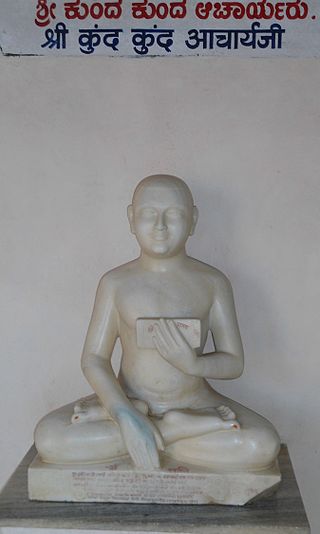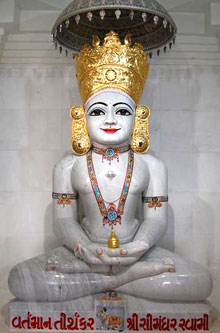Jainism, also known as Jain Dharma, is an Indian religion. Jainism traces its spiritual ideas and history through the succession of twenty-four tirthankaras, with the first in the current time cycle being Rishabhadeva, whom the tradition holds to have lived millions of years ago, the twenty-third tirthankara Parshvanatha, whom historians date to the 9th century BCE, and the twenty-fourth tirthankara Mahavira, around 600 BCE. Jainism is considered to be an eternal dharma with the tirthankaras guiding every time cycle of the cosmology. The three main pillars of Jainism are ahiṃsā (non-violence), anekāntavāda (non-absolutism), and aparigraha (asceticism).

Mahavira, also known as Vardhamana, was the 24th tirthankara of Jainism. He was the spiritual successor of the 23rd tirthankara Parshvanatha. Mahavira was born in the early part of the 6th century BCE into a royal Kshatriya Jain family in ancient India. His mother's name was Trishala and his father's name was Siddhartha. They were lay devotees of Parshvanatha. Mahavira abandoned all worldly possessions at the age of about 30 and left home in pursuit of spiritual awakening, becoming an ascetic. Mahavira practiced intense meditation and severe austerities for twelve and a half years, after which he attained Kevala Jnana (omniscience). He preached for 30 years and attained Moksha (liberation) in the 6th century BCE, although the year varies by sect.

The Śvētāmbara is one of the two main branches of Jainism, the other being the Digambara. Śvētāmbara means "white-clad", and refers to its ascetics' practice of wearing white clothes, which sets it apart from the Digambara "sky-clad" Jains, whose ascetic practitioners go nude. Śvētāmbaras do not believe that ascetics must practice nudity.

Sadhu, also spelled saddhu, is a religious ascetic, mendicant or any holy person in Hinduism, Buddhism, and Jainism who has renounced the worldly life. They are sometimes alternatively referred to as yogi, sannyasi or vairagi.

In Jainism, a Tirthankara is a saviour and spiritual teacher of the dharma. The word tirthankara signifies the founder of a tirtha, which is a fordable passage across the sea of interminable births and deaths, the saṃsāra. According to Jains, tirthankaras are the supreme preachers of Dharma, who have conquered the saṃsāra, the cycle of death and rebirth, on their own, and made a path for others to follow. After understanding the true nature of the self or soul, the Tīrthaṅkara attains Kevala Gyana (omniscience). Tirthankara provides a bridge for others to follow the new teacher from saṃsāra to moksha (liberation).

Parshvanatha, also Pārśvanātha, Parshva, Pārśva and Parasnath, was the 23rd of 24 Tirthankaras of Jainism. He is the only Tirthankara who gained the title of Kalīkālkalpataru.

Buddhism and Jainism are two Indian religions that developed in Magadha (Bihar) and continue to thrive in the modern age. Gautama Buddha and Mahavira are generally accepted as contemporaries. Jainism and Buddhism share many features, terminology and ethical principles, but emphasize them differently. Both are śramaṇa ascetic traditions that believe it is possible to attain liberation from the cycle of rebirths and deaths (samsara) through spiritual and ethical disciplines. They differ in some core doctrines such as those on asceticism, Middle Way versus Anekantavada, and self versus not-self.

Jain monasticism refers to the order of monks and nuns in the Jain community and can be divided into two major denominations: the Digambara and the Śvētāmbara. The monastic practices of the two major sects vary greatly, but the major principles of both are identical. Five mahāvratas, from Mahavira's teachings, are followed by all Jain ascetics. Historians believe that a united Jain sangha (community) existed before 367 BCE, about 160 years after the moksha (liberation) of Mahavira. The community then gradually divided into the major denominations.

Trishala, also known as Videhadatta, Priyakarini, or Trishala Mata, was the mother of Mahavira, the 24th Tirthankara of Jainism, and wife of the Jain monarch, Siddhartha of Kundagrama, of present-day Bihar. She finds mention in the Jain texts.

Mallinatha was the 19th tīrthaṅkara "ford-maker" of the present avasarpiṇī age in Jainism. Jain texts indicate Mālliṇātha was born at Mithila into the Ikshvaku dynasty to King Kumbha and Queen Prajnavati. Tīrthaṅkara Māllīnātha lived for over 56,000 years, out of which 54,800 years less six days, was with omniscience.

Munisuvrat(Munisuvratnath) (IAST: Munisuvratanāth) (Devanagari: मुनिसुव्रतनाथ) (Sanskrit: मुनिसुव्रतः) was the twentieth tirthankara of the present half time cycle (avasarpini) in Jain cosmology. He became a siddha, a liberated soul which has destroyed all of his karma. Events of the Jaina version of Ramayana are placed at the time of Munisuvrata. Munisuvrata lived for over 30,000 years. His chief apostle (gaṇadhara) was sage Malli Svāmi.

Mūrtipūjaka, also known as Derāvāsī ("temple-dweller") or Mandir Mārgī, is the largest sect of Śvetāmbara Jainism. Mūrtipūjaka Jains differ from both Śvetāmbara Sthānakavāsī and Śvetāmbara Terāpanthī Jains in that they worship images of the Tīrthaṅkaras. Mūrtipūjaka may also generally describe members of both the Śvetāmbara and Digambara traditions who use idols (mūrti) in their worship (pūjā).
Jainism is a religion founded in ancient India. Jains trace their history through twenty-four tirthankara and revere Shree Rishabhnatha Bhagwan as the first tirthankara. The last two tirthankara, the 23rd tirthankara Parshvanatha and the 24th tirthankara Mahavira are considered historical figures. According to Jain texts, the 22nd Tirthankara Neminatha lived about 5,000 years ago and was the cousin of Sri Krishna Bhagwaan.
Kevala gyana or Keval gyan also known as Kaivalya means omniscience in Jainism and is roughly translated as complete understanding or supreme wisdom.
Mulachara is a Jain text composed by Acharya Vattakera of the Digambara tradition, around 150 CE. Mulachara discusses anagara-dharma – the conduct of a Digambara monk. It consists twelve chapters and 1,243 verses on. It is also called Digambara Acharanga.
Jain literature refers to the literature of the Jain religion. It is a vast and ancient literary tradition, which was initially transmitted orally. The oldest surviving material is contained in the canonical Jain Agamas, which are written in Ardhamagadhi, a Prakrit language. Various commentaries were written on these canonical texts by later Jain monks. Later works were also written in other languages, like Sanskrit and Maharashtri Prakrit.
Michchhāmi Dukkaḍaṃ, also written as michchha mi dukkadam, is an ancient Indian Prakrit language phrase, found in historic Jain texts. Its Sanskrit equivalent is "Mithya me duskrtam" and both literally mean "may all the evil that has been done be in vain".

Digambara is one of the two major schools of Jainism, the other being Śvētāmbara (white-clad). The Sanskrit word Digambara means "sky-clad", referring to their traditional monastic practice of neither possessing nor wearing any clothes.

Jainism is an Indian religion which is traditionally believed to be propagated by twenty-four spiritual teachers known as tirthankara. Broadly, Jainism is divided into two major schools of thought, Digambara and Svetambara. These are further divided into different sub-sects and traditions. While there are differences in practices, the core philosophy and main principles of each sect is the same.

Aryika, also known as Sadhvi, is a female mendicant (nun) in Jainism.













